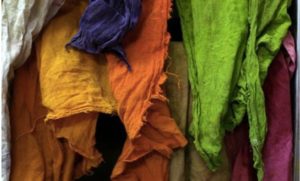I was still working for some of USA’s largest clothing retailers in 2010 when the Beijing’s Bureau of Industry and Commerce conducted a testing of clothing brands and found sixty five had toxic dyes known to cause cancer in the clothing they were shipping to United States and Western Europe.
I recall earlier in 2008 having a large shipment of synthetic jumpers cancelled because the dye was deemed unsafe by the China government when it was allowed to pollute the river and caused extensive damage.
Currently there are 10 dyes that have been shown to cause cancer and have been listed in the Journal of the American Academy of Dermatology and in addition 29 dyes that cause allergies such as contact dermatitis. In addition, formaldehydes and dioxins both known cancer causing chemicals are used to bond dye colors to fabric.

The colors listed as Disperse Blues are causing the largest number of contact dermatitis. There is no simple answer to how to correct this problem. When I tried to use natural pigment dyes in my cotton production in India I was told that the factories were unwilling to change since color was less intense and faded more easily. I did some research and found that metals such as aluminum, copper, iron and chrome are used to make the color stick to the fabric.
I always assumed indigo blue was a natural and the fading in jeans occurred naturally. Actually jeans are made with synthetic indigo. In 2014 the Australian Competition and Consumer Commission (ACCC) recalled over 200,000 pairs of jeans from China they deemed unsafe because the factory an azo dye known to cause cancer.

Although it is possible to find some natural dying in India and there is even a movement towards more natural dying with the popularity of organic cotton there is no such improvement available for synthetic fabrics.
Low impact dyes are specifically tested for skin safety and found in any items that have the GOTS (Global Organic Textile Standard) or Oeko-Tek Certification. I am sure mothers would pay the extra money for baby clothing that gave them this assurance.
The public has to protest the use of chemicals in their clothing and demand that manufacturers take steps to provide safe clothing choices but right now we are more concerned about price.
As long as cost is the most important criteria to consumers we will continue to buy clothing full of chemicals made in unsafe factories where workers suffer terrible disfigurations working with toxic fabrics and chemicals.
We have made some strides in food and many more consumers each year are opting for healthier choices but so far the clothing industry has been lagging behind with little information available to the public to help them make safer clothing purchases.


Comments